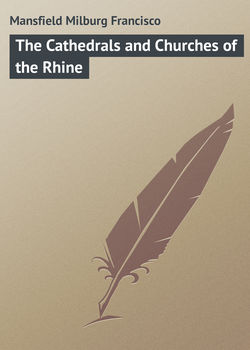Читать книгу The Cathedrals and Churches of the Rhine - Mansfield Milburg Francisco - Страница 1
ОглавлениеAPOLOGIA
The Rhine provinces stand for all that is best and most characteristic of the ecclesiastical architecture of Germany, as contrasted with that very distinct species known as French pointed or Gothic.
For this reason the present volume of the series, which follows the Cathedrals of Northern and Southern France, deals with a class of ecclesiastical architecture entirely different from the light, flamboyant style which has made so many of the great cathedral churches of France preëminently famous.
Save Cologne, there is no great cathedral, either in Germany or the Low Countries, which in any way rivals the masterpieces of Paris, Reims, or Amiens, or even Lincoln or York in England.
Strasburg and Metz are in a way reminiscent of much that is French, but in the main the cathedrals and churches of the Rhine are of a species distinct and complete in itself.
Any consideration of the Rhine cities and towns, and the ecclesiastical monuments which they contain, must perforce deal largely with the picturesque and romantic elements of the river's legendary past.
Not all of these legends deal with mere romance, as the world well knows. The religious element has ever played a most important part in the greater number of the Rhine legends. For demonstration, one has only to recall the legends of "The Architect of Cologne," of "Bishop Hatto and His Mouse Tower on the Rhine," and of many others relating to the devout men and women who in times past lived their lives here.
In the Low Countries also, – at Liège, where we have "The Legend of the Liègeois," and at Antwerp, where we have "The Legend of the Blacksmith," – and indeed throughout the whole Rhine watershed there is abundant material to draw from with respect to the religious legend alone.
As for the purely romantic legends, like "The Trumpeter of Sackingen" and "The Lorelei," there is manifestly neither room nor occasion for recounting them in a work such as this, and so, frankly, they are intentionally omitted.
In general, this book aims to be an account of the great churches in the Rhine valley, and of that species of architectural style which is known as Rhenish.
There is a fund of interesting detail to be gathered in out-of-the-way corners in regard to these grand edifices and their pious founders, but not all of it can be even catalogued here. The most that can be attempted is to point out certain obvious facts in connection with these ecclesiastical monuments, not neglecting the pictorial representation as well.
Tourists have well worn the roads along both banks of the Rhine, from Cologne to Mayence, but above and below is a still larger and no less interesting country, which has been comparatively neglected.
Not all the interest of the Rhine lies in its castled crags or its vine-clad slopes, and not all the history of the middle ages emanated from feudal strongholds. The Church here, as in France, played its part and played it gloriously.
In this discussion of the Rhine churches from Constance to Leyden, the reader will be taken on what might, with considerable license, be called an "architectural tour" of the Rhine, and will be allowed to ramble along the banks of the river, looking in and out of the various religious edifices with which its cities and towns are crowded.
The valley of the Rhine is no undiscovered land, but it served the purpose of the author and the artist well, for it presents much variety of architectural form, and an abounding and appealing interest by reason of the shadows of the past still lingering over these monuments in stone.
